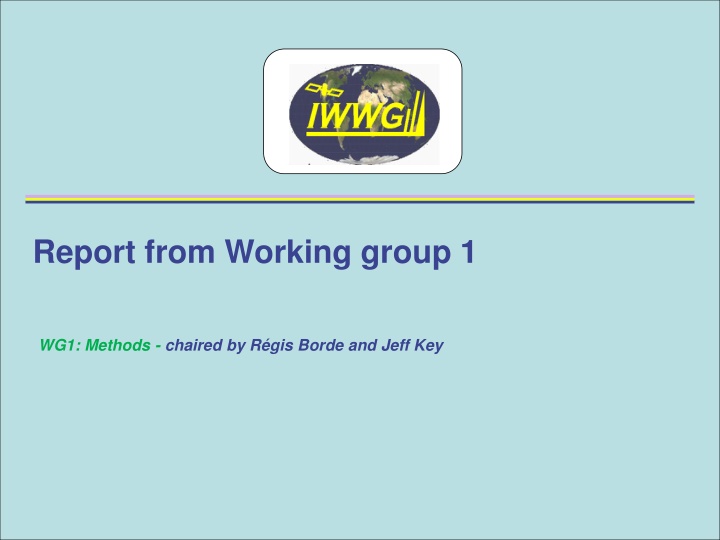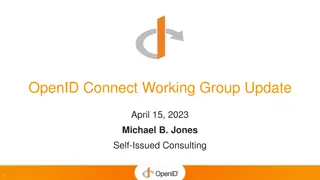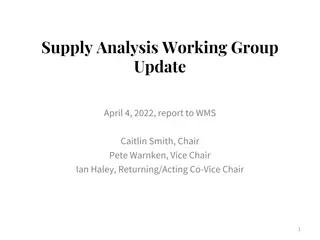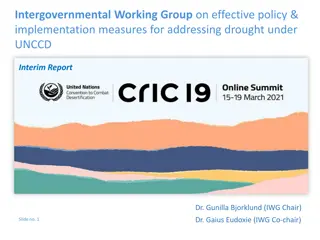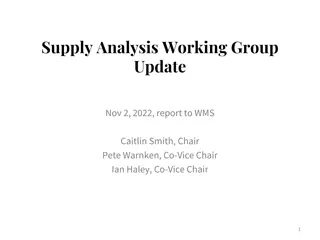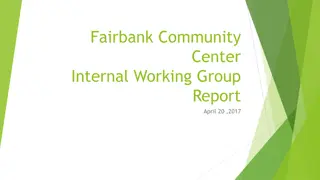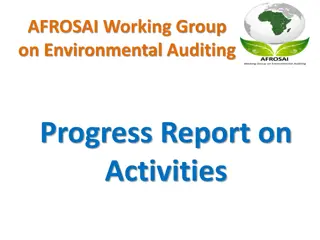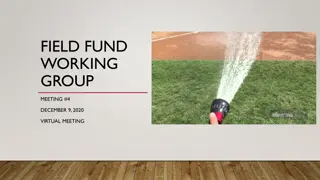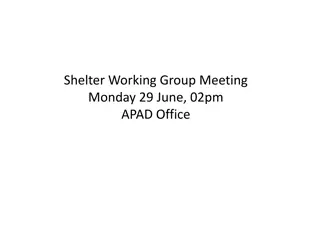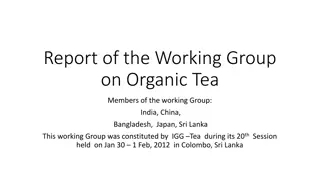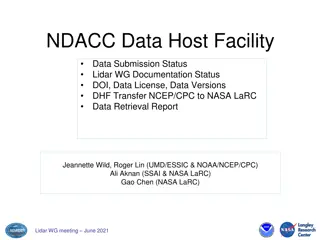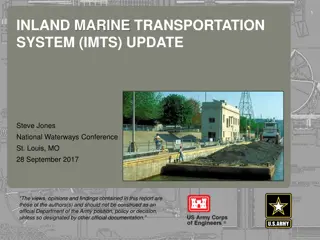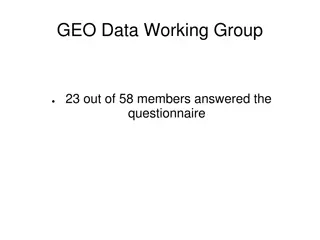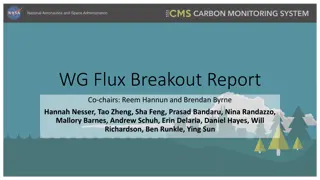Report from Working Group 1: Methods
Recalling Jo Schmetz's talk on high-level priority plans from 2014-2018, the report emphasizes the need for consistency in satellite products across global users. Discussions include establishing commonality in satellite product derivation, sharing prototype algorithms, and encouraging collaboration among producer centers. The report also highlights the importance of better error characterization of satellite data and products, with recommendations for addressing error characteristics, tracking and height errors, and including quality indicators in data products.
Download Presentation

Please find below an Image/Link to download the presentation.
The content on the website is provided AS IS for your information and personal use only. It may not be sold, licensed, or shared on other websites without obtaining consent from the author.If you encounter any issues during the download, it is possible that the publisher has removed the file from their server.
You are allowed to download the files provided on this website for personal or commercial use, subject to the condition that they are used lawfully. All files are the property of their respective owners.
The content on the website is provided AS IS for your information and personal use only. It may not be sold, licensed, or shared on other websites without obtaining consent from the author.
E N D
Presentation Transcript
Report from Working group 1 WG1: Methods - chaired by R gis Borde and Jeff Key
Recalling Jo Schmetz talk 1/3 1. CGMS High level priority plan 2014-2018 -> consistent products (WG1) 3.2 Establish commonality in the derivation of satellite products for global users where appropriate (e.g. through sharing of prototype algorithms); 3.2.1 Infer guidance from the ongoing intercomparison of AMV products for the future developments towards consistent AMV products. Consider in the guidance the future perspective of having the geostationary ring populated with 16-channel imagers. not necessarily same products (friendly competition is beneficial) continue sharing of code, intercomparisons and discussion strive towards more commonality similar approaches based on same science
Recalling Jo Schmetz talk 1/3 1. CGMS High level priority plan 2014-2018 The idea of a single wind retrieval algorithm for all satellites is valid in concept Number of disadvantages; may have hinder innovation, large variety of software programming languages, architectural differences of the systems, inadequate algorithm documentation, additional effort and resources would be required for most groups. The NWCSAF may be the exception in that they have people that can provide the necessary support if their software were adopted by others. There is certainly benefit to utilizing algorithm components Product intercomparisons are critical to determining the quality of algorithm components The experience of the International Cloud Working Group (ICWG) is useful here. ICWG has not settled on a single algorithm and it s not likely that IWWG will either. A single winds algorithm for a given sensor type could emerge someday, particularly as imagers become more similar. IWW12-WG1 Recommendation: Encourage collaboration and share of software between producer centres to compare the methods and algorithms components.
Recalling Jo Schmetz talk 2/3 High level priority plan 2014-2018 (cont.) Better error characterisation (WG1 and WG2) 3.5 Develop, and start implementing, methods to describe the error characteristics of satellite data and products; 3.5.1 Address the error characteristics of wind products at the next International Winds Workshop in 2014 and provide a set of guidelines to be considered at the operational centres What information could be provided and how could it be evaluated and used? Need to consider with change to new BUFR format. There is need to improve the methodology; errors should be traceable to standards whenever possible; scale and flow dependent errors?
Recalling Jo Schmetz talk 2/3 High level priority plan 2014-2018 (cont.) WG1 felt that it is important to separate tracking and height errors. The QI with and without the forecast should continue to be included in winds products. IWW12-WG1 Recommendation: More discussion with wind product users (NWP centres) is recommended in order to determine the optimal error characteristic(s) that should be included in data products. IWW12-WG1 Recommendation: There should be a common QI included by all data producers.
Recalling Jo Schmetz talk 3/3 Reprocessing with unified algorithms (WG1 and WG2) CGMS-42 recommendation: CGMS recommends to CGMS members performing a reprocessing of AMVs, to pursue future AMV reprocessing with their own algorithm and in addition with a common algorithm. IWW12 is invited to discuss the implications and derive guidance on the practical implementations. 2. Is this useful to do? Discuss practical approach for reprocessing by producers. Do we add capability to unified AMV algorithm? How? Who? Other ideas? How best to pursue? Other uses of reprocessed AMVs (WG1 and WG2) Reprocessed AMVs are of scientific interest per se, i.e. beyond their importance to reanalyses, notably in ops4MIPs (observations for model intercomparison projects). They have potential to improve the understanding of processes in the climate system (circulation patterns) 3. Two examples given other examples with MISR and scat by Roger Davies and David Halpern i.Strength of Somali jet and Indian monsoon => direct monitoring from re-processed AMVs ii.Divergence derived from AMVs tracking marine boundary layer clouds => marine Sc/St plays an important role in the climate system (albedo effect) => study link between dynamics/subsidence and cloud characteristics? Other ideas? How best to pursue?
Recalling Jo Schmetz talk 3/3 Reprocessing with unified algorithms (WG1 and WG2) . SCOPE-CM (reprocessing all wind products, both geostationary and polar-orbiting) project has proceeded with different centres reprocessing their own data using their own algorithm. So there is processing consistency for each satellite imager, but not necessarily consistency between satellites. The group agreed that it would be useful for one or more centres to reprocess all data (all satellites) with a single algorithm. Several obstacle have been identified (NWCSAF HRW limited to MSG, potential use of cloud product that does not exist...etc.). 2. IWW12-WG1 Recommendation: The challenges to reprocessing should be described in a short document for CGMS. Other uses of reprocessed AMVs (WG1 and WG2) . Beside re-analysis other uses include the determination of error characteristics, climate studies such as changes in jet stream position and strength, changes in storm tracks, etc. Furthermore, the use of AMVs in reanalysis may help reveal errors in the AMV products. 3.
Recalling Lars Peter Riishojgaardstalk. IWW input to the CGMS baseline (WG1 and WG2) WMO Integrated Global Observing System (WIGOS): a framework for integrating all WMO observing systems under one umbrella. Manual on WIGOS includes a description of the space-based component; this is provided by the CGMS Baseline. The CGMS Baseline talks about operational capabilities and services , and although AMVs are now recognized by WMO as a very important data-type, winds is not listed as a mission for the geostationary constellation Could (should?) be considered a driver for the design and operation of the constellation, in terms of e.g. Orbital spacing Scan mode (full-disc versus rapid) Data processing (temporal and spatial density, ) Data dissemination IWWG recommendation to include wind mission explicitly? Guidance on baseline system e.g. Minimum coverage, interval, frequency... 4.
Recalling Lars Peter Riishojgaardstalk. IWW input to the CGMS baseline (WG1 and WG2) 4. The group agreed that it is important to consider the winds as a driver for the design and operation of new satellite systems and virtual constellations. Not very clear how to formalise this info. IWW12-WG1 Recommendation: The IWWG should investigate the role of winds in the design and operation of future satellite constellations, as described primarily in the Manual on WIGOS. Requirements for wind observations in WMO s Observing Systems Capability Analysis and Review Tool (OSCAR) should also be examined.
Follow up from plenary discussions Intercomparison study (WG1 and WG2) What else could be done for this study? Drilling down to better understand Lessons learned Future studies? How often? Any extra experiments/ideas? 5. High resolution winds (WG1 and WG2) What are NWP requirements to improve high impact weather forecasts? Nowcasting needs, benefits Discuss issues, limitations Who is actively working this problem? Summarize key findings. How to best proceed in the future? How to engage and collaborate with the AMV producers / NWP centres? Provide some recommendations for ways to collaboratively work issues that remain Should a study case be identified for all to work (AMV generation and NWP)? 6. New BUFR format (WG1 and WG2) 7.
Follow up from plenary discussions Intercomparison study (WG1 and WG2) Productive and informative so far. In addition to providing useful information on products and algorithms, it has helped identify problems with the intercomparison process itself. For example, tracking errors were revealed for two of the data producers. Similar to the ICWG/CREW activity, the winds intercomparison will be done incrementally over a number of years. The next intercomparison phase should include improved cloud height assignment and a common quality assessment, perhaps a common QI. It is worth noting that the ICWG/CREW intercomparison project benefitted from a visiting scientist position to help with their website and database. No such resource is available to the IWWG. It was suggested that the MISR cloud heights could be incorporated in the next winds intercomparison study. 5. IWW12-WG1 Recommendation: The intercomparison participants should provide each other with a detailed description of their QI parameter and their cloud height methods. The IWW website should accommodate this information. Because of the resources involved, the next intercomparison study should be in four years.
Follow up from plenary discussions High resolution winds (WG1 and WG2) Discussed in plenary session. 6. IWW12-WG1 Recommendation 7: Study quality indicators that are more appropriate to mesoscale AMV extraction. New BUFR format (WG1 and WG2) Discussed in Plenary session Cloud type, as suggested during plenary, may not provide sufficient information for users who might want to adjust AMV heights based on cloud properties. More quantitative measures were suggested by the WG. 7. IWW12-WG1 Recommendation: It is recommended that the following cloud parameters be included in the BUFR format rather than cloud type: emissivity, particle size, phase, height, single- or multi-layer.
IWWG IWW12 (WG1 and WG2) Thoughts on meeting format, posters Any suggestions for future workshops 8. IWWG web and wiki pages (WG1 and WG2) Thoughts on IWWG web and wiki pages Suggestions to improve? 9. 10. Coordination with new ICWG (WG1 and WG2) What is best approach? Back-to-back meetings with overlap? If so, how often? Joint studies? Ideas for what these could/should be?
IWWG IWW12 (WG1 and WG2) Regarding the 12th International Winds Workshop itself, the only suggestion was that it would have been better to for everybody to be at the same hotel, or at hotels closer to each other. The group had positive comments about the poster session. There were only minor logistical issues. 8. IWWG web and wiki pages (WG1 and WG2) There were no concerns about the IWWG website. 9. 10. Coordination with new ICWG (WG1 and WG2) ICWG could work with the IWWG case study in their own intercomparison. This would identify differences between the height assignment methods. Andy will be the liaison between the two groups for the near-term, subject to ICWG approval. Back-to-back meetings might be difficult to arrange. It was also recommended that at least one person from IWWG attend the next CREW meeting (Lille, France, 2016). .
Method 12. Method topics (WG1) Which aspects still need attention and which are OK? Low level cloud height assignment How tightly constrained is polar tracking to first guess? Any extra considerations for polar AMV height assignment AMVs in tropics Mesoscale vs large scale Inversion correction how applied Cloud microphysics and height assignment Number of levels and frequency of forecasts used for height assignment QI formulation .
Method 12. Method topics (WG1) AMV height assignment still recognised as an important aspect that needs specific attention. It has been suggested to also revisit the QI Same Recommendation than section 6 on HR winds:
Other Items 13. Some other topics (WG1 and WG2) Portable software Feedback on the 6th NWP SAF report collaborative follow-up of specific features? suggestions? Tracking with hyperspectral data Scatterometer wind discussion items MISR; evaluation/monitoring/trials of NRT data, follow-on missions
Other Items 13. Some other topics (WG1 and WG2) Tracking with hyperspectral data, i.e., tracking in moisture retrieval space rather than radiance space, was briefly discussed. One NASA-funded project is underway. EUMETSAT plans to revisit use of optical flow methods applied to moisture fields. There was at least one recommendation during plenary to reduce or eliminate the use of the model background wind field in search for tracers in tracking. There was no strong feeling by the group as a whole on this topic, other than general agreement that using the background is important to polar winds derivation because of the large time interval between orbits IWW12-WG1 Recommendation: Further studies should be undertaken to assess the value of MISR or MISR-like instrumentation for global wind retrieval.
Recommendations from WG1 IWW12-WG1 Recommendation 1: Encourage collaboration and share of software between producer centres to compare the methods and algorithms components. IWW12-WG1 Recommendation 2: More discussion with wind product users (NWP centres) is recommended in order to determine the optimal error characteristic(s) that should be included in data products. IWW12-WG1 Recommendation 3: There should be a common QI included by all data producers. IWW12-WG1 Recommendation 4: The challenges to reprocessing should be described in a short document for CGMS. IWW12-WG1 Recommendation 5: The IWWG should investigate the role of winds in the design and operation of future satellite constellations, as described primarily in the Manual on WIGOS. Requirements for wind observations in WMO s Observing Systems Capability Analysis and Review Tool (OSCAR) should also be examined. IWW12-WG1 Recommendation 6: Study quality indicators that are more appropriate to mesoscale AMV extraction. IWW12-WG1 Recommendation 7: Further studies should be undertaken to assess the value of MISR or MISR-like instrumentation for global wind retrieval.
